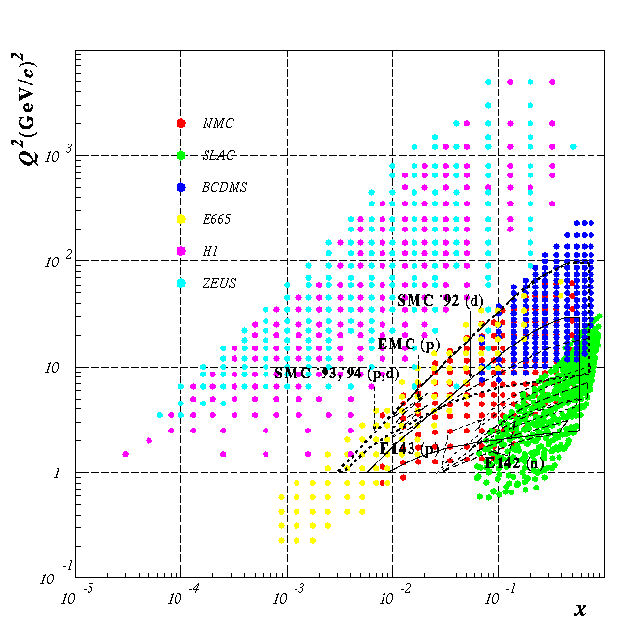 ,
,  of the nucleons have been
determined in a reasonable precision.
of the nucleons have been
determined in a reasonable precision.



The spin structure of the nucleon has been studied for two decades
via polarized lepton scattering off the polarized nucleon target
at SLAC and CERN. As a result, the spin dependent structure
functions  ,
,  of the nucleons have been
determined in a reasonable precision.
of the nucleons have been
determined in a reasonable precision.
Those structure functions are, however, not the direct observables
in the experiments.
The experimentally measured observables are the
asymmetries  and
and  , which are defined as
, which are defined as
where the target polarization is parallel (transverse) to the beam
direction for
 (
( );
);  and
and  are the number of
the scattered
leptons per incident charge for negative and positive beam helicity,
respectively;
are the number of
the scattered
leptons per incident charge for negative and positive beam helicity,
respectively;  is a correction factor for the polarized nuclei other than protons;
f represents the fraction of free proton in the polarized
and target
target;
is a correction factor for the polarized nuclei other than protons;
f represents the fraction of free proton in the polarized
and target
target;  and
and  stands for the polarization of the beam and
target
proton, respectively; and
stands for the polarization of the beam and
target
proton, respectively; and  is the radiative correction
(
is the radiative correction
( ) plus possible false asymmetry.
Those asymmetries,
) plus possible false asymmetry.
Those asymmetries,  and
and  , are related to the
fundamental cross
section asymmetries,
, are related to the
fundamental cross
section asymmetries,  and
and  by
by

Then cross section asymmetries
are multiplied by the unpolarized structure function
 to obtain the spin-dependent structure functions
to obtain the spin-dependent structure functions  ,
,  .
This process will be described in detail in the next section.
The parameters used in the process of obtaining the polarized structure
functions
are summarized in Table i.
.
This process will be described in detail in the next section.
The parameters used in the process of obtaining the polarized structure
functions
are summarized in Table i.
During the two decades of the experiment, the knowledge of the parameters
listed
in Table i has been updated significantly. Especially, the spin
averaged
structure function  is
now well determined using not only DIS data but also high-
is
now well determined using not only DIS data but also high- prompt photon
data, Drell-Yan productions of lepton pairs, and heavy quark productions.
The improvements are due to the precision measurements as well as
the theoretical improvements such as
prompt photon
data, Drell-Yan productions of lepton pairs, and heavy quark productions.
The improvements are due to the precision measurements as well as
the theoretical improvements such as  -evolution in next-to-leading
order (NLO) in perturbative QCD. In Figure 1, available data points
which constrain unpolarized structure function are shown in
-evolution in next-to-leading
order (NLO) in perturbative QCD. In Figure 1, available data points
which constrain unpolarized structure function are shown in  plane.
For comparison, the area probed in polarized DIS experiments are shown.
In the area covered by polarized DIS experiments, there are a lot of unpolarized
data points and the unpolarized structure function can be reliably derived.
(At the same time, one may feel the necessity of extending the polarized study
to larger area.)
plane.
For comparison, the area probed in polarized DIS experiments are shown.
In the area covered by polarized DIS experiments, there are a lot of unpolarized
data points and the unpolarized structure function can be reliably derived.
(At the same time, one may feel the necessity of extending the polarized study
to larger area.)

Figure 1: Existing data points
which constrain unpolarized structure function are shown in  plane.
For comparison, the area probed in polarized DIS experiments are shown.
plane.
For comparison, the area probed in polarized DIS experiments are shown.
Since determination of the spin structure functions in the previous experiments highly depends on the knowledge of the parameters at the time of their publication, we should clarify what parameters were used in the previous experiments to update the spin structure functions, if needed, in a consistent approach.
In this report, we review the analysis procedure of the each experiment and present the result of the consistent analysis.

Table i: List of the parameters used in the analysis of pol-DIS experiments.


